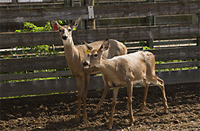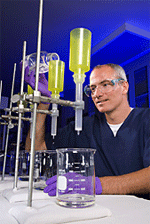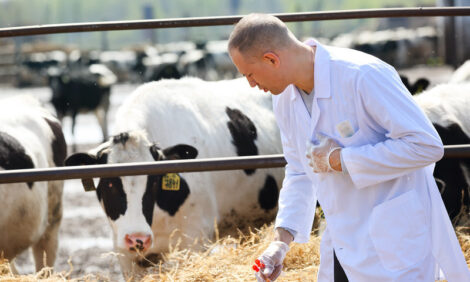



Animal Studies Safeguard Food Supplies—and Human Health
Hundreds of different species of Mycobacterium are known to exist, and many of them have been infecting animals and humans —sometimes with deadly results-for thousands of years, writes Ann Perry, Agricultural Research Service Information Staff of the USDA.
(D1441-1)
Scientists at the Agricultural Research Service’sNational Animal Disease Center (NADC) in Ames, Iowa, are fighting back against two of its most damaging variants—Johne’s disease and bovine tuberculosis (bovine TB).
M. avium subspecies paratuberculosis (MAP) is responsible for the onset of Johne’s disease, which results in losses exceeding $200 million every year to the U.S. cattle industry. Experts believe that almost 70 percent of U.S. cattle herds are infected with MAP, and an animal can spread the disease soon after it is infected. But noticeable symptoms—including severe weight loss and diarrhea—can take up to 5 years to develop.
“MAP is like a stealth organism,” says NADC microbiologist Judy Stabel. “It shelters in the host’s white blood cells and stays at low levels until stress makes the disease apparent. And it’s one of the hardest organisms to work with in the field.”
“We need a better way to detect infected animals early on,” adds NADC microbiologist John Bannantine.
Protein Prospecting

(D1442-1)
The MAP genome—which contains all its genes—has been sequenced, so researchers now have information about the different proteins that are made from those genes. Bannantine and colleagues took some of this genetic data and assembled an array of 96 proteins. They wanted to identify proteins that might be useful in confirming a diagnosis of Johne’s disease or that might be targeted for therapeutic intervention.
The researchers used the 96 proteins in the array to identify which ones prompted the most robust immune response from antibodies in the serum of infected cattle. They found three proteins that consistently drew the strongest attacks from serum antibodies—a level of immune response that clearly linked the three proteins with the onset of the disease. Bannantine believes that with additional work, these segments might provide crucial building blocks for development of a diagnostic tool for Johne’s disease.
“This protein array is the only one like it in the world,” Bannantine says. “Because we’ve been so careful in selecting the MAP proteins for our array, we’re confident that the antibodies are responding to MAP proteins—not similar proteins produced by other Mycobacterium species.”
Bannantine is also very pleased that their studies have cleared up another aspect of MAP infection.
“When an animal is first infected, there is a cell-mediated response to the bacterium,” he says. “We thought that another type of immune response—the one that produces antibodies—developed much later. But in experimentally infected animals, we can use this array to detect exposure to MAP as early as 70 days after the animal is infected, much earlier than previously reported in field studies.”

(D1440-1)
The next step is to determine whether these early-detected antigens are recognized by infected cattle in real-world dairy herds. “We also need to determine the extent of cross-reactivity these proteins have with other environmental mycobacteria, because one problem with current Johne’s disease tests is the lack of specificity,” Bannantine says.
Stabel has been studying more about the early stages of the cell-mediated response to MAP and finding ways to diagnose the disease in young animals. “We’ve found a way to use information about the cell-mediated response to detect MAP in naturally infected calves that are only 6 months old,” she says. “When animals this young are diagnosed, then the producer can decide how best to respond—either by removing the animal from the herd or looking at other options.”
Stabel has also helped evaluate animal models for MAP research and has concluded that a smaller ruminant model—like goats or sheep—shows promise. “These animals are slightly quicker to reach a clinical disease state,” she says.
New Approaches to an Ancient Disease: Tuberculosis

(D1445-1)
The USDA Animal and Plant Health Inspection Service (APHIS) tests more than 1 million animals every year for bovine TB. A lot can ride on the outcome. For instance, from May 2002 through June 2004, 875,616 cows from 687 California herds were tested for bovine TB. As a result, 13,000 cows were culled.
During that time, dairy herd quarantines were enforced to ensure that contaminated milk from infected cows did not enter the human food supply and transmit the disease to people. This additional enforcement cost individual producers as much as $70,000 per month in lost income.
Finding effective diagnostics and vaccines for bovine TB is crucial for livestock and human health and producer profits. At NADC, around 80 white-tailed deer—some so tame that they try to steal food from the pockets of their caretakers—are key to this effort.
“White-tailed deer are a significant reservoir of bovine TB,” says NADC veterinary medical officer Mitch Palmer. “When the deer jump fences and share livestock feed, they can contaminate the feed with TB bacteria. That’s one way cattle herds become exposed to the disease and become infected.”
Vetting Vaccines
Because of the threat wild deer pose to domestic cattle, Palmer and his colleagues have been vaccinating white-tailed deer with the human TB vaccine M. bovis BCG. They want to see whether vaccination could be part of a successful effort to control the disease in wildlife.
“What we’ve found is that the vaccine is effective in decreasing the severity of the disease and that oral vaccination appears to be as effective as subcutaneous vaccination,” Palmer says. “But we have some safety concerns. Because it’s a live vaccine that stays in body tissues for up to 250 days, bacteria in the vaccine that prompt the protective immune response might also infect humans who consume venison from vaccinated deer. And vaccinated deer can shed the vaccine and expose other animals to the disease.”

(D1447-1)
The vaccine research has yielded other significant findings as well—including results that could affect human health.
NADC molecular biologist Tyler Thacker led studies indicating that in white-tailed deer, levels of interferon gamma (IFN-gamma)—a protein that is critical in the immune response to bovine TB infection—increase as the severity of the infection increases. This finding countered previous studies suggesting that levels of IFN-gamma rose when the immune system of a vaccinated animal was successfully fighting the pathogen.
Other results in the study suggested that elevated levels of IL-4, another immune protein, could be found in animals with lower infection levels. This also contradicted research with other animal species suggesting that IL-4 levels increase with disease severity.
“These results give us more accurate information about whether a trial vaccine is effective,” Thacker says. “Vaccine testing is expensive, so it’s helpful to have screening tools for interpreting results. Now that we know IFN-gamma is not a good predictor of vaccine efficacy, we can start looking for other indicators.”
The NADC scientists have also been using neonatal calves to test human TB vaccines. This approach is cheaper and safer to use than testing in nonhuman primates.
“We’ve devised a very effective method for inoculating neonatal calves with TB by using an aerosol challenge,” says NADC veterinary medical officer Ray Waters. “This gives us new options for testing human TB vaccines on animals with immune responses that closely resemble the human immune response.”
In addition, the most common time for administering the vaccine to humans is soon after birth—timing that is mimicked when neonatal calves are used for tests. The neonatal calf tests are currently the most effective bridge between testing in mice and nonhuman primates. Results have so far been very similar to the findings in nonhuman primates.
Vaccines or Diagnostics—Which Comes First?

(D1446-1)
“Vaccine development and diagnostic development are intertwined,” Thacker observes. “If we find indicators that predict immunity, then maybe we can refine those indicators and use them for diagnostic testing as well.”
Thacker, Palmer, and Waters are working on improving bovine TB tests for cattle. “We have serum-based tests that are not approved for use in the TB eradication program yet,” Palmer says. “But they are showing some potential for testing samples in the field, where time or temperature could affect the stability of the blood samples.”
Meanwhile, producers and APHIS staff often use a commercial blood-based test called “Bovigam” to confirm a preliminary positive skin test diagnosis of bovine TB.
“Standardizing the protocol for using Bovigam is still a work in progress,” says Waters. “Labs have been running different test protocols, so we’re working on establishing standard measures for processing blood samples. For instance, we’ve found that using vessel plates to test samples is just as effective as using tubes, and with vessel plates we don’t need to use as much of the reagent to obtain accurate results. We also need to determine optimal schedules for collecting and processing samples—and we need to determine a safe temperature range for maintaining those samples before they reach the lab.”
Into the Wild
Animal health depends as much on meticulous fieldwork as it does on painstaking lab studies. So Waters, Palmer, and Thacker were part of a team that obtained blood samples from 760 wild deer and surveyed them for bovine TB, the largest such sampling to date. The team found that the blood tests accurately identified an infected animal about 70 percent of the time. On the other hand, the tests correctly identified a noninfected animal about 90 percent of the time.
Palmer explains, “With most tests of this type, there’s typically a tradeoff between the accuracy of positive and negative results. We’re continuing to work on this because we’d like to get both numbers in the high 80s or low 90s.
“We’re approaching bovine TB research from a range of perspectives, but all of it helps us understand the immune response,” Palmer continues. “When an animal is infected with TB, tissue destruction is caused by the host reacting to the TB pathogen. We want to understand what is causing the tissue destruction, which will help us find ways to treat the disease and intervene in the process of tissue destruction.”
May 2009


